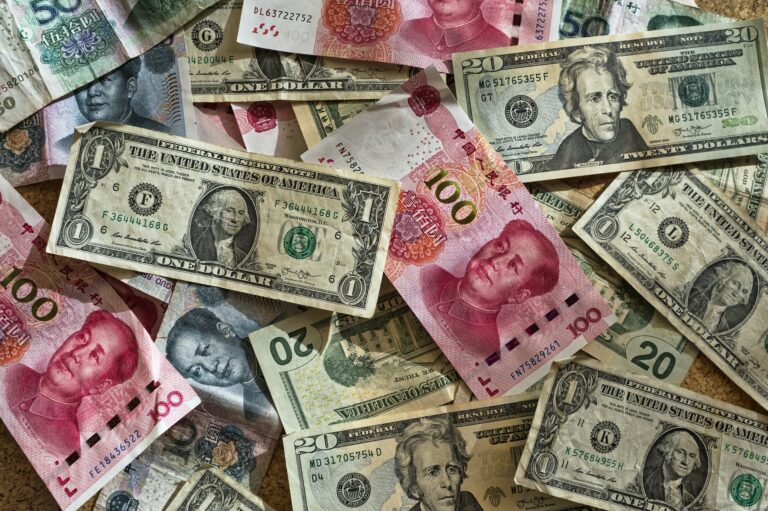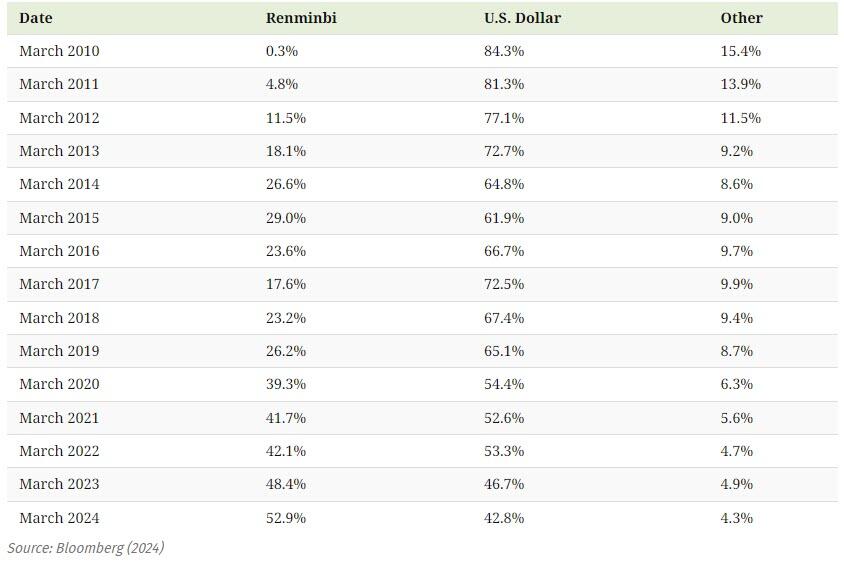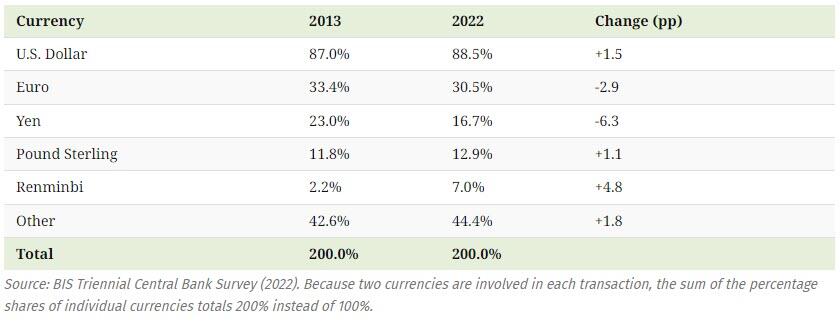DeDollarization or Yuanization. What is the direction of the economy in the world of currencies

The global financial landscape is undergoing a subtle but significant transformation. At the center of this change is the concept of " de-dollarization ", or the gradual reduction of the dominance of the US dollar in international trade and finance, while keeping the concepts of "Trade" and "Finance" separate .
While this process has been underway for years, it has recently gained momentum, fueled by China's growing use of its own currency, the yuan (or renminbi), for cross-border transactions. This shift away from the dollar, while gradual, has the potential to reshape the global economic order, at least when it comes to payment for goods .
A less dollar-centric world could mean a redistribution of power, influence and economic leverage. It could also lead to increased volatility and uncertainty in financial markets. As China continues to assert its economic power, the rise of the yuan represents a significant challenge to the established order. In this article we will delve into the factors driving China's de-dollarization efforts, the impact on the global currency landscape, and the potential implications for the future of international trade and finance. We will analyze the rise of the yuan, the strategic considerations behind China's actions, and the challenges and opportunities that lie ahead.
The de-dollarization of China's cross-border transactions
Historically, China, like many other nations, has relied heavily on the US dollar for its international trade and financial transactions. In recent years, however , this dependence has been waning , as China actively promotes the use of its own currency.
In 2010, less than 1% of China's cross-border payments were settled in yuan, compared to a staggering 83% in US dollars. In March 2023, a pivotal moment occurred: the yuan surpassed the dollar for the first time. As of March 2024, over half (52.9%) of Chinese payments were settled in yuan, a notable doubling of the share in just five years. You can see the data in the following table:
This drastic change can be attributed to several factors:
- First, there is an increasing willingness on the part of foreign businesses to trade in yuan, as they seek to diversify their currency holdings and reduce their exposure to the dollar.
- Second, several countries, including Brazil and Argentina, have started to accept yuan settlements for trade, further strengthening its international use.
The Chinese government and its central bank, the People's Bank of China (PBOC), have played a crucial role in driving this trend. They have implemented policies to facilitate the use of the yuan in cross-border trade and investment, including the establishment of offshore yuan clearing houses and the expansion of the network of bilateral currency swap agreements.
The rise and retreat of the yuan The rise of the yuan in international trade has been marked by several significant milestones. In 2016, the yuan was included in the International Monetary Fund's (IMF) Special Drawing Rights (SDR) basket, a reserve asset used by member countries. This move recognized the yuan's growing importance in the global economy and paved the way for its wider adoption.
However, the path to a globalized yuan has not been without setbacks. In 2015-2016, China faced a speculative attack on its currency, triggered by concerns about the country's economic slowdown and capital outflows. This forced the PBOC to intervene to stabilize the yuan, highlighting the challenges of managing a currency with growing global exposure.
Changing priorities and capital controls
The 2016 crisis led to a reevaluation of China's de-dollarization strategy. While the initial ambition was to achieve large-scale de-dollarization and expand the Belt and Road Initiative (BRI), a massive infrastructure investment project, the focus has shifted to a more cautious approach.
China has begun to prioritize the development of yuan-denominated trade settlement systems, allowing businesses to avoid the dollar in their transactions. The government also tightened capital controls to avoid excessive outflows and maintain financial stability. These measures, while effective in protecting the economy, have also limited the yuan's global reach.
The dollar's dominance in international trade has long been a source of power and vulnerability for the United States. It allowed the United States to impose economic sanctions on other countries by limiting their access to the dollar-based global financial system.
This “weaponization” of the dollar has raised concerns in many countries, particularly those at odds with US foreign policy. As a result, interest in finding alternatives to the dollar has grown, with the Chinese yuan emerging as a potential competitor.
The most popular currencies in foreign exchange (FX) transactions, i.e. finance is another matter
Despite the rise of the yuan, the US dollar remains the undisputed king of the foreign exchange market. According to the Bank for International Settlements, it accounted for 88.5% of all foreign currency transactions in 2022, followed by the euro (30.5%) and the Japanese yen (16.7%). Interestingly, the dollar's share has grown by 1.5% since 2010, while that of the euro and yen has declined.
The renminbi, while still a relatively small player with a 7% share, has been the fastest growing currency in the FX market over the past decade. This suggests that it is gradually establishing itself as a viable alternative to the dollar, especially in trade with China and its partners.
De-dollarization or yuanization?
Although complete de-dollarization of the global economy seems unlikely in the near future, the rise of the yuan is undeniably a significant trend. As China's economic influence continues to expand, the yuan is expected to play an increasingly important role in international trade and finance.
The Chinese government is actively promoting the use of the yuan in cross-border transactions and is steadily building the infrastructure needed to support this goal. This includes establishing yuan clearing banks in major financial centers, expanding the currency swap agreement network, and developing new yuan-denominated financial products.
However, the path to yuanization is not without challenges. China's strict capital controls, while necessary to maintain financial stability, limit the yuan's international appeal. Furthermore, the value of the yuan is still tightly managed by the PBOC, which raises concerns about its long-term stability and predictability.
If the Yuan really wants to become a currency equal to, if not superior to, the dollar at the level of global trade, it is necessary for central bank controls on transactions to be loosened, especially abroad. If we evaluate the Yuan instead as a financial currency, in in this case the basic problem is the return on assets in Chinese currency, which is not particularly interesting at the moment for international investors. Unfortunately, it is not easy, if not impossible, to achieve both results simultaneously in the short to medium term.

Thanks to our Telegram channel you can stay updated on the publication of new Economic Scenarios articles.
The article DeDollarization or Yuanization. What is the direction of the economy in the world of currencies comes from Economic Scenarios .
This is a machine translation of a post published on Scenari Economici at the URL https://scenarieconomici.it/dedollarizzazione-o-yuanizzazione-quale-la-direzione-delleconomia-nel-mondo-delle-valute/ on Fri, 09 Aug 2024 09:50:57 +0000.


